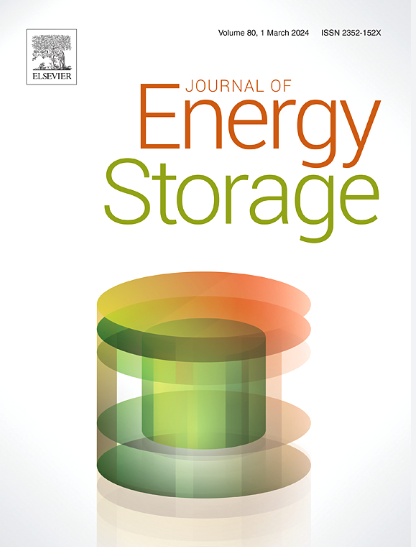柔性超级电容器用煤焦油沥青制备的无粘结剂集成独立电极的三碳界面工程
IF 8.9
2区 工程技术
Q1 ENERGY & FUELS
引用次数: 0
摘要
开发具有高成本效益、高机械强度和优异电化学性能的柔性电极对于推进柔性准固态超级电容器(FSCs)具有重要意义,但也极具挑战性。以煤沥青(CTP)为碳材料前驱体,碳布(CC)为柔性衬底,通过简单高效的界面设计策略,制备了具有优异电化学性能和力学性能的集成化、独立化、柔性电极。首先在CC上构建聚多巴胺碳界面(PA),并在该界面上原位生长从CTP中获得的n掺杂多孔碳,形成集CC、碳界面和多孔碳于一体的三碳柔性电极(CC-PA- pc)。由于结构上的优势,与不含碳界面的电极(CC-PC)相比,制备的电极具有更好的电化学性能。使用CC-PA-PC电极组装的对称FSCs在0.5 mA cm - 2时的面电容为1303.6 mF cm - 2,能量密度为0.18 mWh cm - 2,显著高于相同条件下CC-PC电极的相应值625.4 mF cm - 2和0.087 mWh cm - 2。此外,基于cc - pa - pc的FSCs具有优异的柔韧性和机械稳定性。这种柔性电极的设计策略为粉末多孔碳在柔性超级电容器中的应用提供了一条途径。本文章由计算机程序翻译,如有差异,请以英文原文为准。
Interface engineering of triple carbons for binder-free integrated freestanding electrodes derived from coal tar pitch for flexible supercapacitors
The development of flexible electrodes that are cost-effective, possess high mechanical strength and superior electrochemical performance is of significant importance but highly challenging for advancing flexible quasi-solid-state supercapacitors (FSCs). Herein, the integrated, freestanding, and flexible electrodes with excellent electrochemical and mechanical performance were fabricated via a facile and efficient strategy of interface design, with the carbon material precursor of coal tar pitch (CTP) and the flexible substrate of carbon cloth (CC). A polydopamine carbon interface (PA) was first constructed on the CC, and N-doped porous carbon obtained from CTP was grown in situ on the interface to form a triple‑carbon flexible electrode integrating CC, carbon interface, and porous carbon (CC-PA-PC). Ascribing to the structural advantages, the as-prepared electrode presents improved electrochemical performance compared to the electrode fabricated without the carbon interface (CC-PC). The symmetric FSCs assembled using the CC-PA-PC electrode demonstrate a superior areal capacitance of 1303.6 mF cm−2 at 0.5 mA cm−2 and an energy density of 0.18 mWh cm−2, significantly exceeding the corresponding values of 625.4 mF cm−2 and 0.087 mWh cm−2 for the CC-PC electrode at the same conditions. Moreover, CC-PA-PC-based FSCs exhibit excellent flexibility and mechanical stability. This design strategy for flexible electrodes provides a pathway for the application of powdery porous carbons in flexible supercapacitors.
求助全文
通过发布文献求助,成功后即可免费获取论文全文。
去求助
来源期刊

Journal of energy storage
Energy-Renewable Energy, Sustainability and the Environment
CiteScore
11.80
自引率
24.50%
发文量
2262
审稿时长
69 days
期刊介绍:
Journal of energy storage focusses on all aspects of energy storage, in particular systems integration, electric grid integration, modelling and analysis, novel energy storage technologies, sizing and management strategies, business models for operation of storage systems and energy storage developments worldwide.
 求助内容:
求助内容: 应助结果提醒方式:
应助结果提醒方式:


